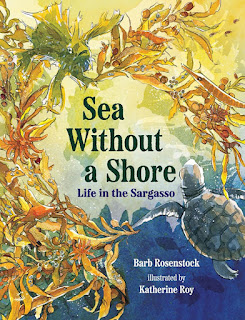Barb Rosenstock is the author of the new children's picture book Sea Without a Shore: Life in the Sargasso. Her many other books include The Noisy Paint Box. She lives near Chicago.
Q: What inspired you to write Sea Without a Shore?
A: I literally tripped on the idea for this book. We were on a family vacation in the Dominican Republic. While walking on the beach in the morning my feet got tangled on some seaweed. I had to sit down to pull it off my feet.
I’d never really looked at seaweed before and noticed that this seaweed had what I thought were “berries” on it. I searched “seaweed with berries,” on my phone, learned I had tripped on Sargassum seaweed, and that those “berries” were air floats, which made me curious about how this seaweed lived, why it was there, and what its purpose was…and that started more than a year of research.
Q: How did you research the book, and what did you learn that especially surprised you?
A: I began with a good library search at home. That turned up only one old book on Sargassum and the Sargasso Sea, a ton of recent news stories on how Sargassum is overrunning beaches, and a Nat Geo article on the Sargasso Sea that really helped my overall understanding. That article was written by famed oceanographer Sylvia Earle, who wound up contributing to the book’s back matter!
I switched to reading science journals on the Sargasso and getting in touch with their authors. I was invited by Dr. Kerry Whittaker to a multi-day Sargasso symposium for students at Woods Hole Oceanographic Institution, which gave me access to folks from the Sargasso Sea Commission and scientists studying the Sargasso currently.
That research all wound up turning into a trip to Bermuda with Dr. Kerry, Dr. Robbie Smith, and illustrator Katherine Roy to see the Sargasso’s creatures in person.
I was surprised to learn that seaweed are algae not plants, but more surprised that this specific species of Sargassum algae in the Sargasso Sea doesn’t have roots, seeds, or spores.
So, it reproduces by fragmentation, or cloning! Sargassum seaweed clones itself out there in the middle of nowhere. A bit of it the size of your fingernail can turn into an acre-sized mat. That is just amazing to me, still.
Q: What do you think Katherine Roy’s illustrations add to the story?
A: I think Katherine is a genius. My text is about a faraway place that is not accessible to many humans and all the strange creatures that live there.
Katherine’s illustrations set that story first in a child’s community and then brings us out to the ocean community of the Sargasso, and then back in a way that’s intertwined.
She takes my ideas about the Sargasso’s life and its home in the weed and gives it a richness and context that I couldn’t have dreamed of. As I said, genius.
Q: The Kirkus Review of the book says, “Youngsters will be sucked into this engaging, informative account of a most unusual ecosystem.” What do you think of that description?
A: Well, if Kirkus said it, then it must be true, right? 😊 Actually, I’m quite grateful that the reviewer understood the book and gave it a starred review, because it’s certainly what Katherine, I, and the team at Norton were going for…the strange and yet fascinating story of life mid-ocean, and how our own lives on this beautiful planet relate to places we’ve never imagined.
Q: What are you working on now?
A: I have my first YA nonfiction book out next April, titled American Spirits, about three sisters before and during the American Civil War who became famous by talking to the dead.
That will be followed by Houdini’s Library, illustrated by Mar del Mar, which will come out in 2026 for the 100th anniversary of Houdini’s death on Halloween in 1926.
Other than that, right now I’m hunting for the next idea: eugenics, Emily Dickinson, old farms, light pollution…not sure which of those will turn into a book, we shall see.
Q: Anything else we should know?
A: Back to Sargassum and other seaweeds, when they do overrun beaches, it’s not because the seaweed is some space invader that needs total eradicated.
Instead, these abnormally large seaweed blooms and inundations are almost always due to human actions…our overuse of commercial fertilizers, climate change, etc. So, we should ALL get involved in helping the earth in some way. It’s time to save our home!
--Interview with Deborah Kalb. Here's a previous Q&A with Barb Rosenstock. This Q&A was prepared in partnership with W.W. Norton. Enter this giveaway for a chance to win a hardcover edition of Sea Without a Shore, autographed by Barb Rosenstock and Katherine Roy.



No comments:
Post a Comment